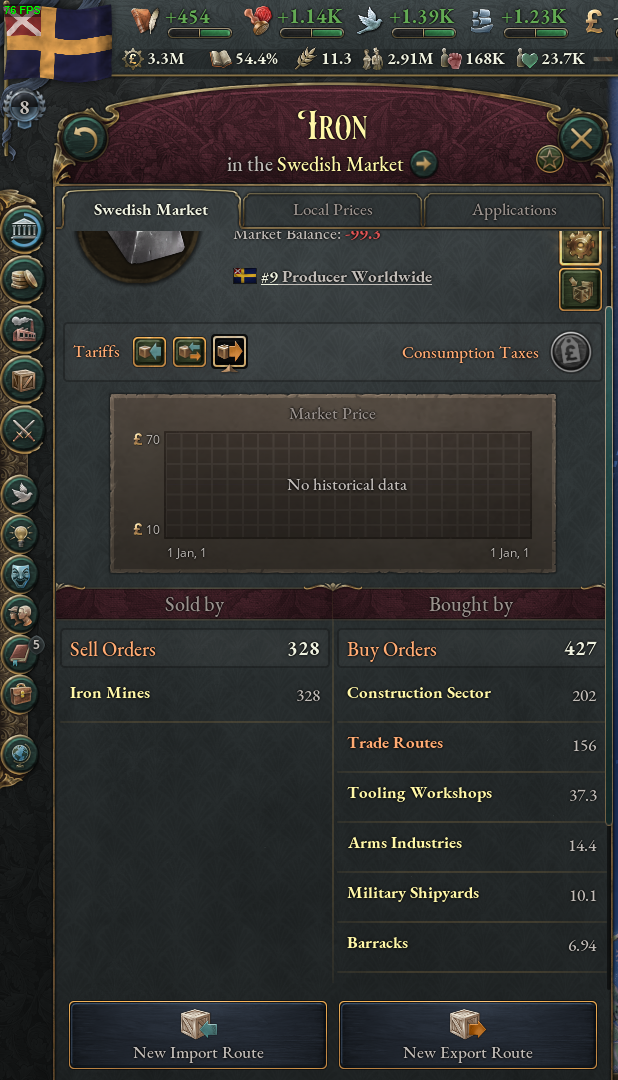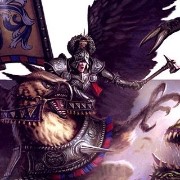|
Red Bones posted:I dunno if it's particularly ahistorical, this is pretty much how the 19th century went for most countries. Yeah the pressure to get stronger at the same pace as your rivals and threats is really the only reason to expand outside of pure map painting. The game stops being fun when there's no one who can threaten you, and the only way to have threats throughout the campaign (other than introducing new ones like the mongols or Anbennar's obsidian dwarves) is to slow down the player's scaling or make the AI at least somewhat competitive, which in EU4 it is definitely not. If I get outscaled on a reasonably level playing field by EU5's AI I will be extremely satisfied.
|
|
|
|

|
| # ? Apr 28, 2024 23:27 |
|
MatchaZed posted:I mean, expanded scope mods start in the 1350s, it's a bit of a stretch but it could happen. Johan has been vocal about how much he disliked the In Nomine start date (1399), so it's a little hard to believe he'd go even earlier.
|
|
|
|
Magissima posted:Yeah the pressure to get stronger at the same pace as your rivals and threats is really the only reason to expand outside of pure map painting. The game stops being fun when there's no one who can threaten you, and the only way to have threats throughout the campaign (other than introducing new ones like the mongols or Anbennar's obsidian dwarves) is to slow down the player's scaling or make the AI at least somewhat competitive, which in EU4 it is definitely not. If I get outscaled on a reasonably level playing field by EU5's AI I will be extremely satisfied. I guess it could be part of the difficulty settings, to define how much the AI cares about that, kept separate from other aspects of the difficulty. Dr. Video Games 0031 posted:Johan has been vocal about how much he disliked the In Nomine start date (1399), so it's a little hard to believe he'd go even earlier.
|
|
|
|
Something like V3's diplomatic plays could work well. If France or Austria or Aragon try to expand in Italy, everyone else who's interested in Italy would have a chance to intervene if the aggressor has AE or is at a certain power rank (iirc Imperator's connection of diplomatic options to rank had good ideas), but wouldn't necessarily join a generalized coalition. Try to make each war as an aggressive and blobbing power have aspects of coalitions coming together to oppose you instead of having the coalition be a massive all or nothing war that can be juked around. That sounds kind of unfun in EU4 but hopefully they can make large wars more manageable and ideally find a way to keep wars contained to one region, or like x regions at a time where x depends on war goals, raised army size, tech, etc. Magissima fucked around with this message at 06:42 on Mar 15, 2024 |
|
|
|
A Buttery Pastry posted:If they leaned into the idea that countries actually cared about the balance of power, and let the AI care a lot more about keeping any country getting uncomfortably large down, then you would get push-back before you got too big to shrug that off. Like, everyone in Western-to-Central Europe should want to cut down to size a France that gobbles up Burgundy, only chilling out a bit if say Austria united the HRE with their other territories and created an eastern counter-balance to France. That would do a lot to add some friction during the part of the game where the player usually starts snowballing. the problem - and i think it is a problem, i'm not sure how to solve it - is that ok, you get the AI caring a ton to keep a single country from becoming too powerful. eventually the player will beat that, and probably not much longer than currently. now we're back to square one. without reflecting internal politics or tensions or what-have-you, I don't think you can solve this via just external factors
|
|
|
|
what if its vicky 4
|
|
|
|
Magissima posted:Yeah the pressure to get stronger at the same pace as your rivals and threats is really the only reason to expand outside of pure map painting. The game stops being fun when there's no one who can threaten you, and the only way to have threats throughout the campaign (other than introducing new ones like the mongols or Anbennar's obsidian dwarves) is to slow down the player's scaling or make the AI at least somewhat competitive, which in EU4 it is definitely not. If I get outscaled on a reasonably level playing field by EU5's AI I will be extremely satisfied. I could argue that once you're not under existential threat the game still provides a fun task of optimizing conquest. You wonder who to attack at which point to have enough manpower, if you don't want to fight someone for a truce period then maybe you can Threaten War one province out of them. But obviously it's a little different game and the immersion disappears, cause no country (at least in this period) ever felt there are no threats, but at certain point of the game you can clearly see that you can play cookie clicker with development and will still end up being #1 power in the world without ever going to war again, yeah. End game crises like Stellaris are obvious solution but they won't feel as good in a historical game. You can always spawn a Napoleon in relative proximity to the player but it will feel cheap and goes against the simulation idea.
|
|
|
|
I read the dev diaries and I'm cautiously excited for Victoria Universalis. It also makes me wonder if there's been any cross-polination of ideas and concepts between Tinto and the MEIOU and Taxes dev team, since that mod is essentially EU4 squashed into a Victoria shape, in many ways.
|
|
|
|
HerpicleOmnicron5 posted:what if its vicky 4 YF-23 posted:I read the dev diaries and I'm cautiously excited for Victoria Universalis. 
|
|
|
|
What gaps are left in the current paradox line up? Is it just Late Antiquity?
|
|
|
|
20/21th century?
|
|
|
|
Pretty interesting dev diaries. I was thinking about what I actually care about in Victoria pops, and it 's mostly - seeing literacy go up - seeing pop number go up - cultural conversion to primary culture All of those are obviously gonna be much slower than in Vicky simply due to the different time period.
|
|
|
|
 What a ride.
|
|
|
|
Victoria 3 beginner's question: Under the Construction tab of the Buildings section, the Construction Sector tooltip says: quote:There are 5 levels of Construction Sector in Sweden Elsewhere, the Construction Sector tooltip also says: quote:Goods consumption: So, if there are 5 levels of Construction Sector, then the total Iron consumption, just for Construction, would be [50.0 * 5] = 250 Iron If I go over to the Rural tab, and mouse-over Iron Mines, the tooltip says: quote:Goods Production: So, if there are 9 levels of Iron Mines, then the Iron production would be [20.0 * 9] = 180 Iron but since the 5 levels of Construction Sector would be consuming 250 Iron, then that's a shortfall of [250 - 180] = 70 Iron, just for feeding the Construction Sector In order to make up that shortfall, I'd need another [70 / 20] = 3.5, rounded up to 4 levels of Iron Mines. At the same time though, each level of Iron Mine consumes 5.0 Tools, so if I went from 9 levels of Iron Mines, to 13 levels of Iron Mines, the Tools consumption of just the Iron Mines would be [5.0 * 13] = 65.0 Tools Going over to the Urban tab, and mousing-over the Tooling Workshops, the tooltip says: quote:Goods Production: So that comes out to 120 Tools, which means I should be covered... at least in terms of what 13 levels of Iron Mines would demand. That said, the Tooling Workshops themselves would consume 40.0 Iron (and 30.0 Wood) per level, which is 80.0 Iron for the two levels, so if I add that on to the Iron that would be consumed by the Construction Sector, that's a total of 330 Iron, which means my shortfall in Iron goes up from 70 to 150, which means I'd need not just 4 additional levels of Iron Mines, but 7.5, rounded up to 8.0 At [9.0 + 8.0] = 17 levels of Iron Mines, the Tools consumption would be 85 Tools, which is still covered by the current amount of Tooling Workshops that I already have... assuming nothing else consumes Tools. But indeed, the Construction Sector itself consumes Tools; at 10.0 per Level, that means the 5 levels of Construction Sector are consuming 50.0 Tools, so Tools consumption is now at [85 + 50] = 135, which is 15 more than what my two levels of Tooling Workshops can produce, so I would need more of them... but more Tooling Workshops would consume more Iron, which means... ___ 1. Does this make sense in terms of trying to figure out what I should actually be building? 2. The entire discussion above only covers Iron... I would still have to figure out my Construction Sector's needs for Wood, and Fabric, and so on, but is there somewhere in the interface that gives one big total consumption of Iron (or Wood, or Tools) for all sources, so that I know at a glance if I'm at a deficit or surplus of a particular good/resource (domestically)? The Market screen doesn't seem to be much help. Obviously one approach would be to simply over-build production, but it'd be nice to have an idea of where to start (or stop).
|
|
|
|
You can just look at supply and demand in the market screen. You can literally sort by differential between the two, and also click on each individual good to see what produces and what consumes it.
|
|
|
|
I just look at the little piles of coins and if there are two of them it means that (if the goal is to make cheaper) then I can afford to build more of the resource. If you try to do the maths like you’re doing above you’ll go insane once deeper in the game. It doesn’t matter if things imbalance as you build of one supply: eventually you’ll reach equilibrium, on top of providing better job for all (so better salary so better quality of life so better attractive country) etc
|
|
|
|
1. In broad terms, yes. 2. The market screen does display the total surplus or deficit you have of each good in your market. There's a few things to keep in mind here: - You do not need to completely erase deficits for your input/output chain to be properly fed. Goods that are in deficit are simply more expensive, and you only suffer from actual penalties to your buildings if the deficit is steep enough. So you can deal with some things just being somewhat more expensive. You'll generally want them to be cheap, especially for stuff you are paying directly such as construction, but it isn't the end of the world if you don't. - Goods surplus/deficit is market-wide, so other countries in your market also contribute to supply and demand (as well as trade routes in and out of the market). So if you have a deficit in a good it is not completely necessary to make up for it with direct construction, though it's the most straightforward way. - Buildings will not necessarily fully hire, so while you may have those stats on how much goods each level of a factory produces or how much it needs how much it will actually need and produce will depend on its employment status. A 10-sized tooling workshop in a market where tools are dirt cheap but iron/steel/wood are very expensive will not hire fully and will not demand or produce as many goods as its full capacity suggests.
|
|
|
|
gradenko_2000 posted:Victoria 3 beginner's question: Markets and construction have changed a little since I last played (a year ago), but the gist of it from what I remember is that everything feeds into everything else. The only clear "start point" really is construction, because you need construction to build poo poo to meet the demand present in your market. And generating demand becomes the name of the game. In the early game, it really can be just construction for the most part generating demand. Build lots of construction buildings, then build lots of mines, lumber mills, and tool workshops to support the construction buildings, then build more construction buildings, etc. It's a good way to kickstart your economy. Feel free to dip into the red while doing this, as long as you don't go too heavily in debt. Later on, you'll be trying to improve your pops' standard of living, which will increase the amount of goods they demand, which gives you good reason to build tons of factories. edit: and yeah, don't worry about balancing out resources exactly. production volumes are abstract figures that feed into the pricing algorithm and don't represent discrete goods that get consumed or traded. having not enough iron just means iron is a bit more expensive. you should build more iron mines, but sometimes it's correct to build lots of construction first. (edit 2: it's possible to have a severe shortage of input goods that hampers production, but aside from that the only consequence is price) Dr. Video Games 0031 fucked around with this message at 13:53 on Mar 15, 2024 |
|
|
|
Also in the beginning of the game local production has a bigger impact, since not everything produced gets on your global market (that’s “Market Price Impact” modifier which some tech/laws have. Higher equals more produce reach globally)
|
|
|
|
YF-23 posted:The market screen does display the total surplus or deficit you have of each good in your market. Do you mean this?  if I try to read this: my Iron Mines are producing a total of 328 Iron my Construction Sector is consuming a total of 202 Iron my Tooling Workshops are consuming a total of 37.3 Iron ... and so on my total consumption of Iron (i.e. all the Bought By line-items sans Trade Routes) comes out to 270.74 if I add the Trade Route line-item to that, it comes out to 426.74, which is already what the Buy Orders total says because my domestic consumption (270) exceeds my domestic production (328), I have a surplus, and that surplus is getting exported to provide a profit, and that's how I know I'm already producing enough Iron, and could afford to build more things that consume Iron (all else being disregarded) is that about right?
|
|
|
|
Also unless you're in some of the more extreme economy laws, your market isn't an island onto itself -- everyone knows you can manage your own import/export routes to other markets, but I think a lot of people overlook that other markets will also initiate import/export routes to/from your market themselves as well. It's an easy notification to overlook when it happens, and it's why you'll be running a huge deficit of <material> and suddenly that deficit clears itself -- because an AI nation saw the prices for Widgets were insanely high in your market because of the shortage and it initiated its own export route into your market to take advantage of it. You can also influence prices to a degree by selecting the good in the market screen and choosing to focus on imports or exports for that particular good via tariff policy. By default it seeks a balance between the two. gradenko_2000 posted:is that about right? Not quite. You are running a total deficit of 99 iron in your market (see "Market Balance" at the top of the window in your screenshot) because you are exporting too much, which makes sense because your tariff law is set to focus on exports for Iron. For your iron mines themselves this is fine -- it means their goods are being purchased and are in demand, and so they're probably turning a nice profit. But it's not so good for the availability of iron in your market, which you ideally want to be at something close to equilibrium. Drone fucked around with this message at 13:37 on Mar 15, 2024 |
|
|
|
|
In this scenario, I'd slam that "Protect Domestic Supply" button and build more construction buildings and tool workshops to use up that iron yourself. There are some goods that can be good to export, but resources like Iron are generally not among them. You're better off making use of those resources yourself in your domestic economy. edit: that said, as sweden you're gonna have half of europe trying to muscle in on your iron supply. good luck Dr. Video Games 0031 fucked around with this message at 13:42 on Mar 15, 2024 |
|
|
|
Yeah, as Sweden (or really any country) you'll be better off protecting raw materials and exporting finished or intermediary goods (like steel) imo. Unless you're going for an extraction-based economy strat, which is certainly valid depending on the country you're playing, what your goals are, and which market you're in. As Sweden your biggest obstacle to that will be not having a great supply of coal, which is where the map-painting comes into play. Benin is one of the go-to opening colony spots for many players for that reason. Drone fucked around with this message at 13:55 on Mar 15, 2024 |
|
|
|
|
There's also another screen somewhere- i think the market tab on the side of the ui- that shows all your goods with both the absolute difference and the current price modifier. And as people said the thing to keep in mind is that shortages and surpluses* don't mean stuff is wasted but rather that things become more expensive *up to a 75% shortage, which actually applies debuffs to production
|
|
|
|
Quote is not edit.
|
|
|
|
|
gradenko_2000 posted:2. The entire discussion above only covers Iron... I would still have to figure out my Construction Sector's needs for Wood, and Fabric, and so on, but is there somewhere in the interface that gives one big total consumption of Iron (or Wood, or Tools) for all sources, so that I know at a glance if I'm at a deficit or surplus of a particular good/resource (domestically)? The Market screen doesn't seem to be much help. YF-23 posted:2. The market screen does display the total surplus or deficit you have of each good in your market. gradenko_2000 posted:Do you mean this?  No, the market screen, the main one, the one the big button on the sidebar takes you to:  The balance column in the centre there is your deficit or surplus in unit numbers and then the price column will tell you how far over or under base price that puts you. It's not going to tell you if the price levels are an actual problem, of course...
|
|
|
KOGAHAZAN!! posted:
To add on to that, I've seen new players fall into a trap of misinterpreting this screen. Take Explosives for example in your screenshot, which is existing currently in equilibrium -- there are just as many buy orders for sell orders. This might make a player come to the inaccurate conclusion that if they want to use more explosives for anything (say opening a gold mine that uses nitroglycerin in the production methods), that they should build out another Explosives factory first. This is generally not the case, as the existing Explosives factory in this market-equilibrium state is probably not producing at capacity, meaning that if the demand for Explosives suddenly goes up (because you built that explodey gold mine), the existing factory will react accordingly and hire more workers to produce more Explosives to bring the cost of the good back to equilibrium. The game doesn't really surface this particular information very well though, and to uncover that you'd have to actually look at the factory screen itself. And in the scenario where that factory was somehow already running at capacity, the only immediate effect will be that the good gets more expensive (making production later in the chain more expensive as well). This doesn't lead to outright shortages of the material unless the demand really explodes (heh), but the market will seek equilibrium in any way it can, e.g. by having a foreign market take advantage of the imbalance in your market by exporting their cheaper Explosives to you. Not saying that gradenko is doing any of this, but in a discussion about the market screen and assessing your country's production, it's probably worth mentioning. Drone fucked around with this message at 14:15 on Mar 15, 2024 |
|
|
|
|
A surplus doesn't automatically mean you should export it, yeah. Having a surplus makes your domestic industries that use those goods more competitive by making their inputs cheaper, and even if you don't care about that in itself it means that you can expand them without needing to also invest in expanding their inputs. Sometimes it might make sense to export stuff you have more than you know what to do with, but with raw resources the demand is generally going to keep growing so there isn't that much point.
|
|
|
|
Important gameplay concept which you might have not realised because it's weird: Goods in V3 don't need to be specifically bought or sold to generate value, all goods which are produced will be consumed, even if the total amount of demand (i.e. buy orders) in your market is below the sell orders. Similarly all goods which are inputs to a building will be purchased, even if the total number of sell orders in the market is below the input amount. The difference between buy and sell orders is what generates the local and market prices, but you can never have a shortage or surplus of goods, except where you have more than 2x the number of buy orders as sell orders, in which case you get a penalty to output (the building still works though, and can work with literally zero inputs) So you don't necessarily need to export a surplus of raw resources in order to generate value from them, because that surplus will result in your industries which require those resources being more profitable; but equally, exporting wood and iron can be excellent ways of making a lot of money under the right circumstances, you don't necessarily have to have a full supply chain within your own country. In particular, this sort of strategy can let you efficiently focus certain techs; for example if you have ample coal, iron and sulphur resources available, then going hard on the mining and explosives techs and running an export-heavy economy can be very viable. Companies also work well with this sort of approach.
|
|
|
|
If you have no idea what to build then the coal/iron/steel/tools loop is pretty much always and forever going to be a useful place to put your construction points, along with expanding your construction sectors as the budget can bear, and wood production in the early game particularly. It might not be the absolute most profitable thing possible (in fact it probably isn't), but coal/iron/steel/tools go into pretty much every single other production chain (including each others') and keeping the basic inputs cheap will let your capitalists' AI more effectively chase the profits that you don't have a fine enough sense of the game to find yourself yet. And like others have said, you don't actually want your goods to be at perfect market equilibrium most of the time. The core coal/iron/steel/tools industrialization loop you want to be as cheap as possible because it feeds everything else, which means overproducing those goods so there's a surplus in your market, driving down the prices and direct profitability of the immediate buildings. But the cheap inputs for other industries will more than make up for it in total GDP growth, as well as tools in particular being a golden export good that pretty much every other market will want to buy from you forever because the AI is trash at developing enough of their own. Set wood/coal/iron/steel/tools trade policy to protect domestic supply so your market gets first dibs when possible, and then (particularly with a nice high value finished good like tools) any foreign markets that are desperate enough to buy through the protectionist tariff barrier will generate a decent amount of government income for you to play with to make up for taking that cheap input away from your domestic capitalists. Crazycryodude fucked around with this message at 14:37 on Mar 15, 2024 |
|
|
|
Did Victoria 2 have discrete units of goods that had to be bought and sold?
|
|
|
|
Farecoal posted:Did Victoria 2 have discrete units of goods that had to be bought and sold? It did, but it also had the global market which was like a massive clearing house for stuff which wasn't used for your own market, and it had unrestricted price ranges so things always sold eventually
|
|
|
|
Farecoal posted:Did Victoria 2 have discrete units of goods that had to be bought and sold? Yeah it tracked actual material balance of goods as discrete units rather than just floating price pools that summon/dismiss goods out of the void like V3 does. Which was maybe more realistic for your Marxism Simulator, but I imagine must have been hell on performance and gameplay. Led to frustrating things like being completely unable to buy a single unit of Good X ever because your prestige was too low and all the countries above you bought the entire world market's supply before you could, whereas in V3 you can get your hands on at least small quantities of everything by just paying obscene rip-off prices that summon some of Good X from the shadow realm.
|
|
|
|
Radia posted:the problem - and i think it is a problem, i'm not sure how to solve it - is that ok, you get the AI caring a ton to keep a single country from becoming too powerful. eventually the player will beat that, and probably not much longer than currently. I do agree that you need some sort of internal mechanism to prevent snowballing, to the point that I basically take it for granted that this is necessary. EU would in my mind benefit a lot from a system of diminishing returns for territories that outpace your capacity to control them, meaning even relative minor countries could put up a real fight against their far larger neighbors in the early game, with only later-game improvements letting the big boys push ahead. From a game mechanics point it's perfect as an (early) anti-snowball measure, it mirrors the historical process of minor states becoming increasingly irrelevant, but also allows a minor state to push ahead in its administration and thus be able to fight the big boys on a more equal footing and ideally grow to the point that it still has a chance when the big boys catch up. Magissima posted:Something like V3's diplomatic plays could work well. If France or Austria or Aragon try to expand in Italy, everyone else who's interested in Italy would have a chance to intervene if the aggressor has AE or is at a certain power rank (iirc Imperator's connection of diplomatic options to rank had good ideas), but wouldn't necessarily join a generalized coalition. Try to make each war as an aggressive and blobbing power have aspects of coalitions coming together to oppose you instead of having the coalition be a massive all or nothing war that can be juked around. As you say, some adjustment to the game mechanics to make interventions something you want to avoid for sensible in-world reasons, rather than because it because unmanageable from a purely game mechanics stand point would definitely be nice. First option would be to make it so armies are limited to fighting in the region where the intervention takes place, so the anti-Austrian coalition sticks to defending Italy rather than attacking the Austrian Netherlands or whatever. In the scenario where the intervention against Austria is on a European level, it would of course be fine to attack everywhere in Europe, but now you're avoiding having to deal with annoying attacks on like Austrian Australia.
|
|
|
|
Crazycryodude posted:Yeah it tracked actual material balance of goods as discrete units rather than just floating price pools that summon/dismiss goods out of the void like V3 does. Which was maybe more realistic for your Marxism Simulator, but I imagine must have been hell on performance and gameplay. Led to frustrating things like being completely unable to buy a single unit of Good X ever because your prestige was too low and all the countries above you bought the entire world market's supply before you could, whereas in V3 you can get your hands on at least small quantities of everything by just paying obscene rip-off prices that summon some of Good X from the shadow realm. Yeah, honestly I like vicky 3's market systems. I don't like having to micromanage stockpiles and trade stances. And if I can't buy enough silk or whatever, I just throw up my hands and accept that silk will cost +75% for a while. And the system works out so that if you have a large demand for luxury clothes that isn't being met, your clothes factory can still be profitable producing them even with the production penalty and +75% price for silk.
|
|
|
|
gradenko_2000 posted:Victoria 3 beginner's question: The Market screen will show the total production and consumption of a good within your market if you hover your mouse a good. The number of Sell Orders is how much production there is, and the number of Buy Orders is how much consumption there is. The Balance column is just buy orders minus sell orders, so if it's negative for a good then that means you're consuming more than you're producing. It's worth noting that you don't actually need enough production to match your consumption. If your industry consumes more than you're producing, the only immediate consequence is that the market price for that good will increase beyond the base price. You don't actually run into shortages and factory slowdowns until your demand is more than double your supply; until then, your economy will magically conjure the missing goods out of nowhere in exchange for higher prices. On the other hand, if your produce more than you consume, the market price for that good will be lower than the base price, so it can be good to overproduce to a certain extent, especially for fundamental base materials like wood and iron that you're never going to have trouble using up. In general, I just use the market price as a guide for what I need to produce more of. If the price of something is higher than base, then I'm not producing enough of it, so I increase production. If I want the price lower than base, then I produce even more. If I'm trying to plan out production more precisely, I look at the Balance value to determine my current actual surplus/deficit of the good. The basic national economic model is actually quite simple that way, though the market access price modifiers tend to complicate things in the early-game. gradenko_2000 posted:Do you mean this? Not quite, because exporting is going to happen regardless of whether you have a surplus or not, and goods do not prioritize your local production over exporting. Your trade centers have just as much of a claim on those goods as your factories do, the game won't prioritize one over the other. Your sell orders are 328 and your buy orders are 427, so you have a deficit, which is causing Iron to be probably 10-20% more expensive in your market than base price. The fact that your domestic production is only about half of that and that the deficit is caused entirely by exporting doesn't actually matter. You have to start building more iron mines, because your economy can't really afford much more of a deficit. You won't have actual shortages until your buy orders reach 656, so your factories can continue running at full speed despite this deficit, but the elevated iron prices are substantially cutting into your factories' profit margins. It's pretty much impossible to build yourself into actual shortages, because rising prices will drive your factories into bankruptcy and your trade routes to ruin long before your market deficit gets high enough to get slapped with the "shortages" modifier. Your government is making some profit by exporting iron, and that should be a fairly profitable trade route since you're exporting a fair amount of iron at higher than base price. But by exporting that iron, you're driving up the iron prices in your own domestic economy, making it more difficult for your factories to make a profit, which in turn means that your workers and capitalists are making less money, which in turn means that your population isn't as happy and doesn't have as much money for you to tax. It's a common mistake - a lot of stuff that seems to bring in money for your government actually comes at the expense of your population or industry, which slows the growth of your economy, leaving you less able to bring in money through taxation. If you had a massive surplus of iron, then sure, you could export some (you don't want the iron mines to go bankrupt from overly-low prices either), but I'd aim to balance the production and export levels such that the iron price remains lower than its base price even with the exports. Iron's just too important for industrial production. Vizuyos fucked around with this message at 15:02 on Mar 15, 2024 |
|
|
|
The arguably most popular massive historical mod for EU4, Mayo and Texas, starts in 1356, and the main reason it is limited to absolute grogs is how the population stuff is awkwardly forced into EU4 interfaces. I think the start date tracks with EU5, and not a brand new overlapping game. Also, Imperator is more fun than any of the "good" Paradox games right now. Do any of the haters actually play it?
|
|
|
|
I like the period but I heard so many bad things about the game back in the day that I never bought it Maybe one day when it gets very cheap
|
|
|
|
I say it every time this topic comes up but making a game which covers the exact time period of Imperator is really difficult because it needs to have tiny city states, barely cohesive tribal entities, and massive empires covering most of Europe and / or the Middle East and making playing all of those fun. The map setup for Imperator is extremely hostile towards compelling gameplay without a huge amount of extra work to fix this problem. I always thought that a Classical Greece period Paradox game would be amazing, with the Achemenid empire being a non-playable faction, but I guess a major portion of the people interested in classical antiquity are in it primarily for Rome and Carthage so I can understand why these games always have to be set during the Hellenic period or later
|
|
|
|

|
| # ? Apr 28, 2024 23:27 |
|
I hate the period and I heard so many bad things about the game back in the day that I never bought it.
|
|
|




























